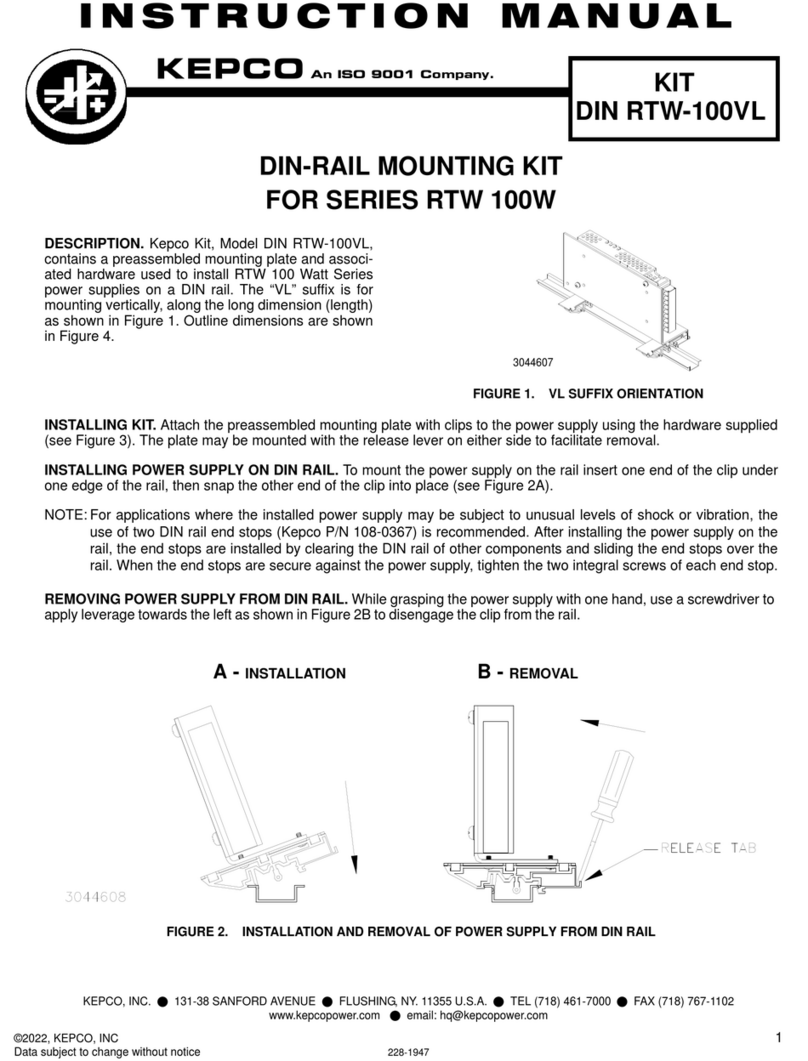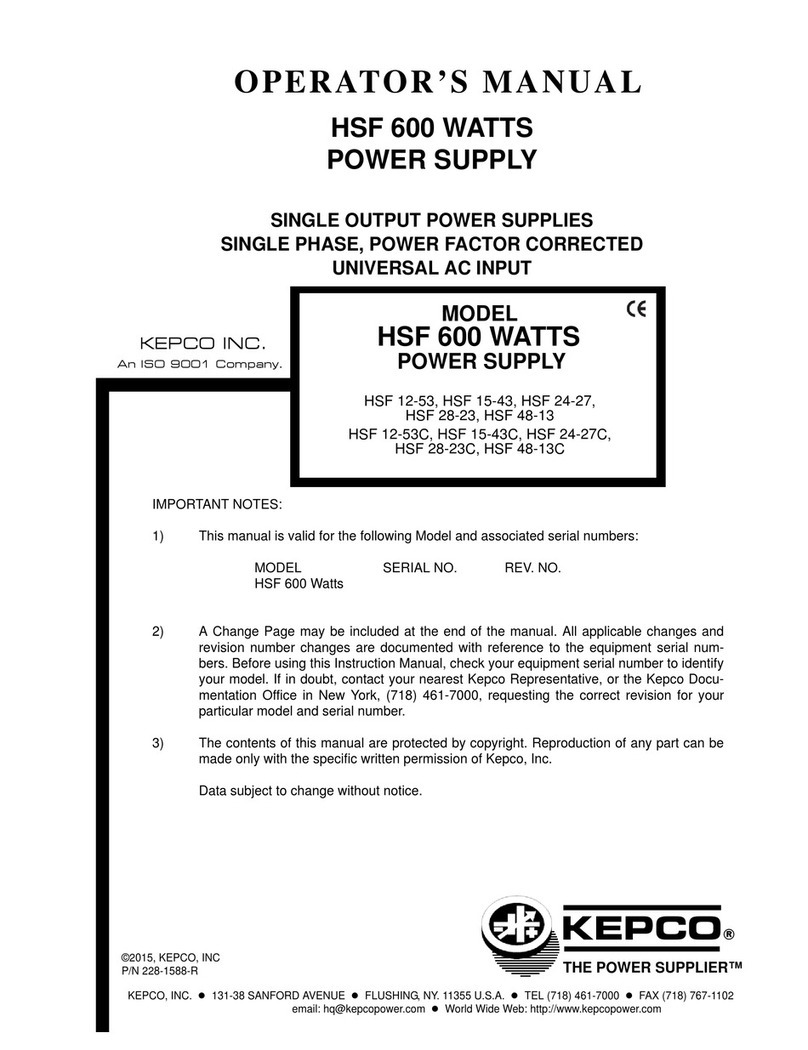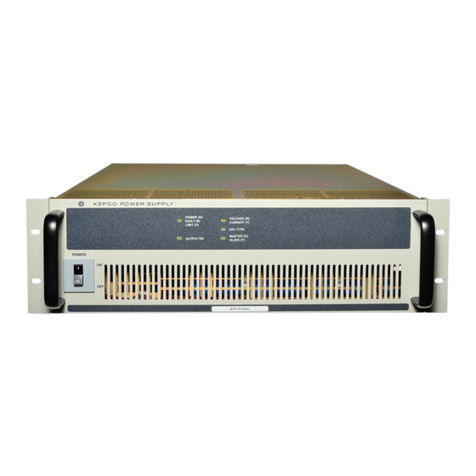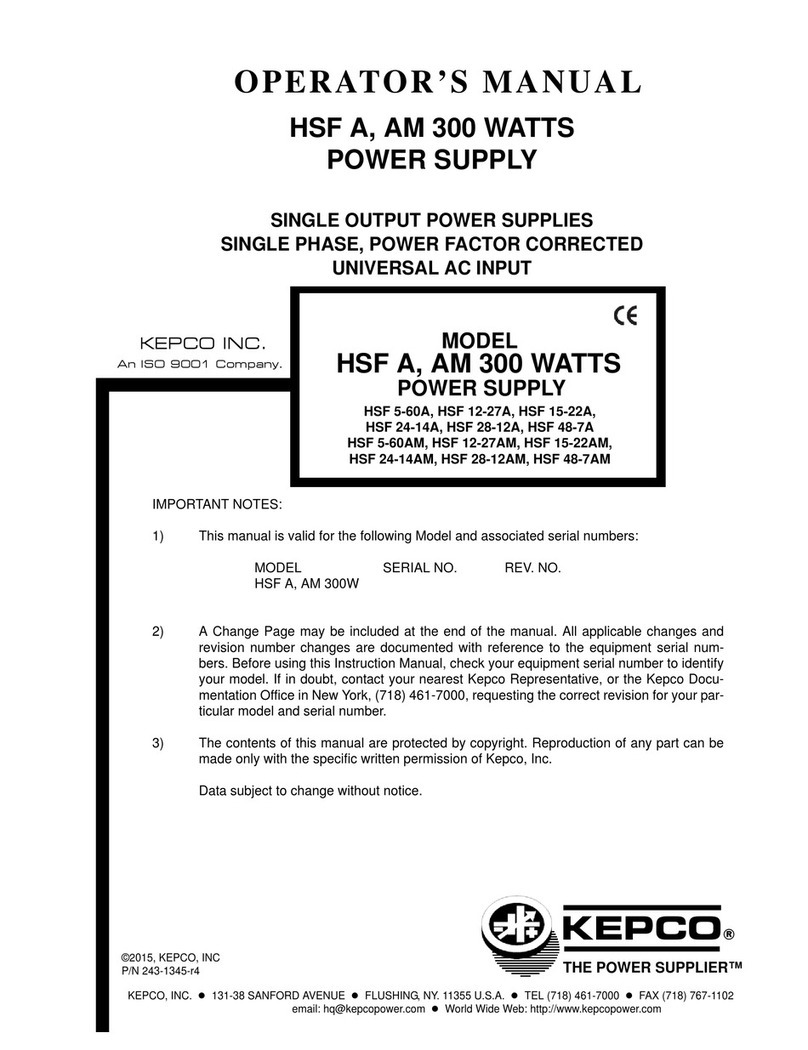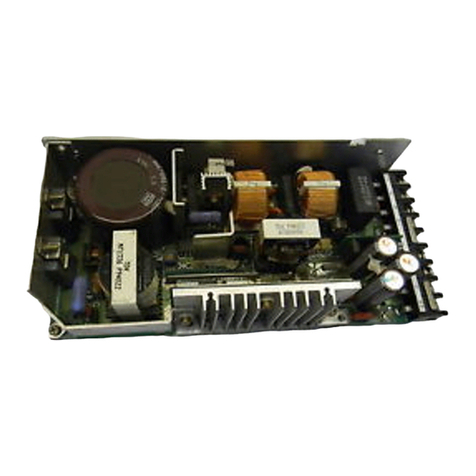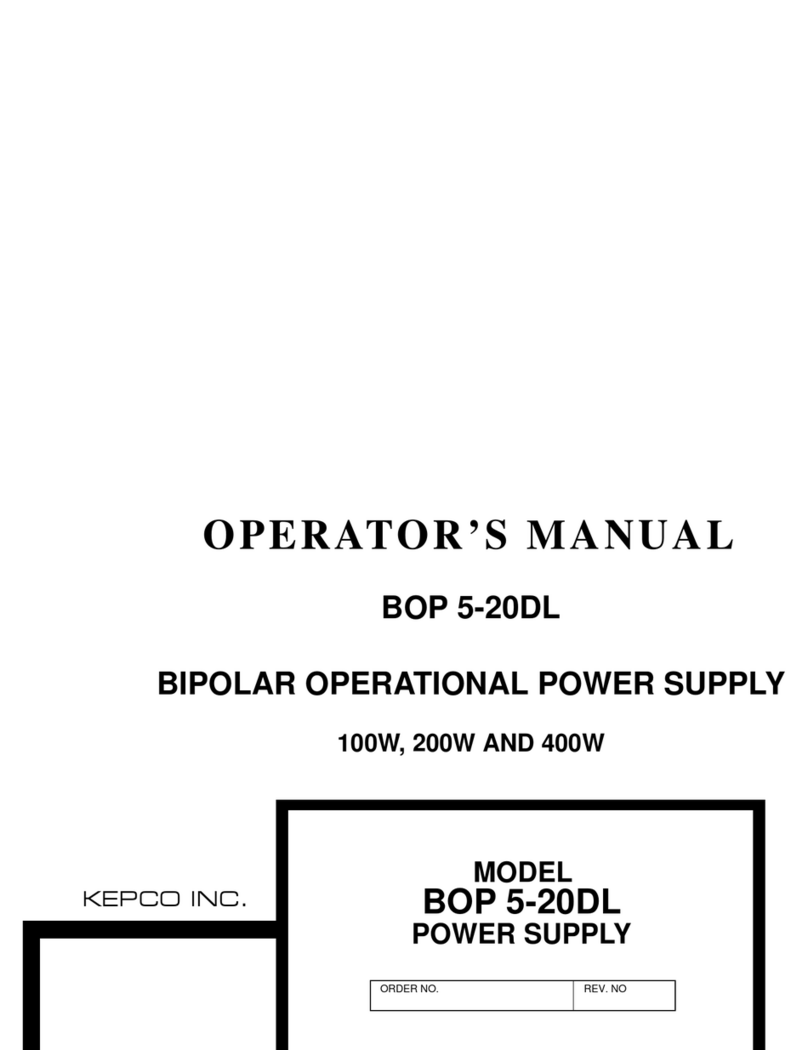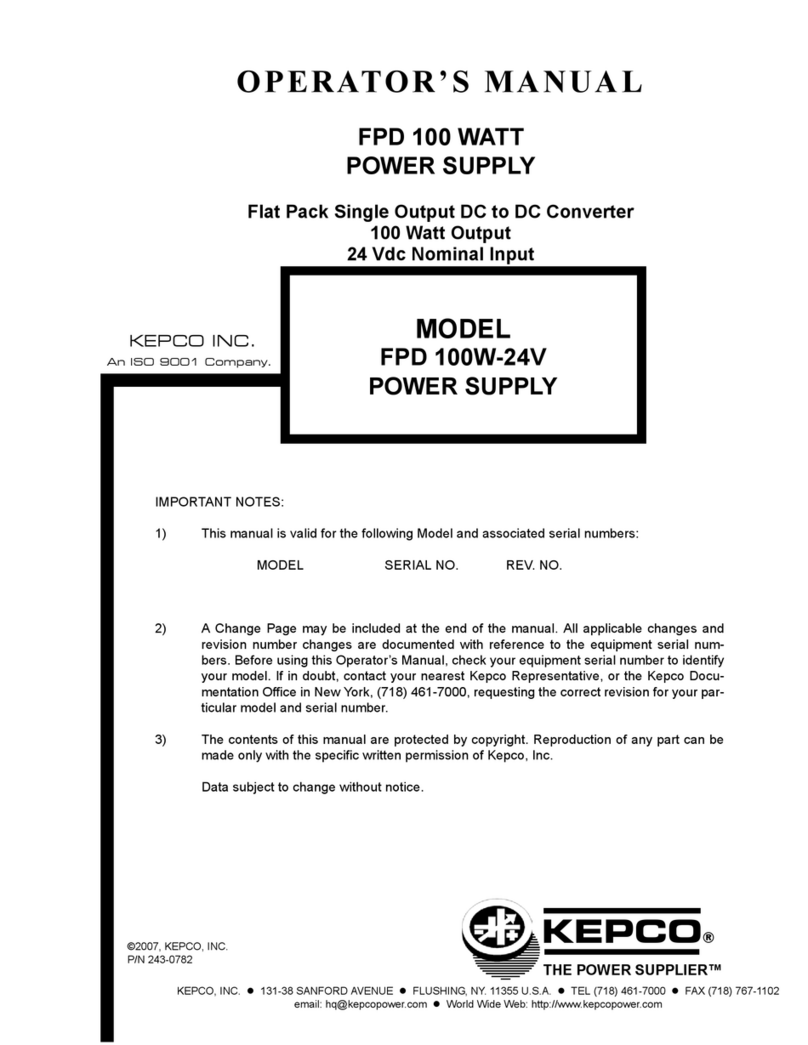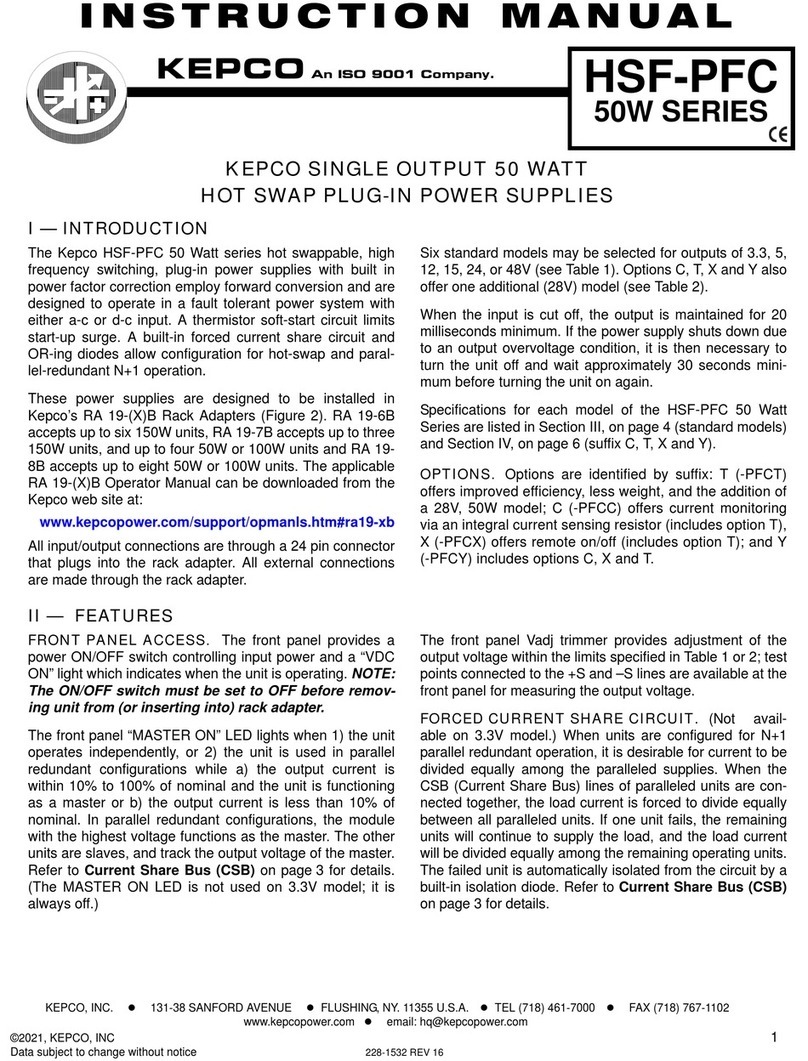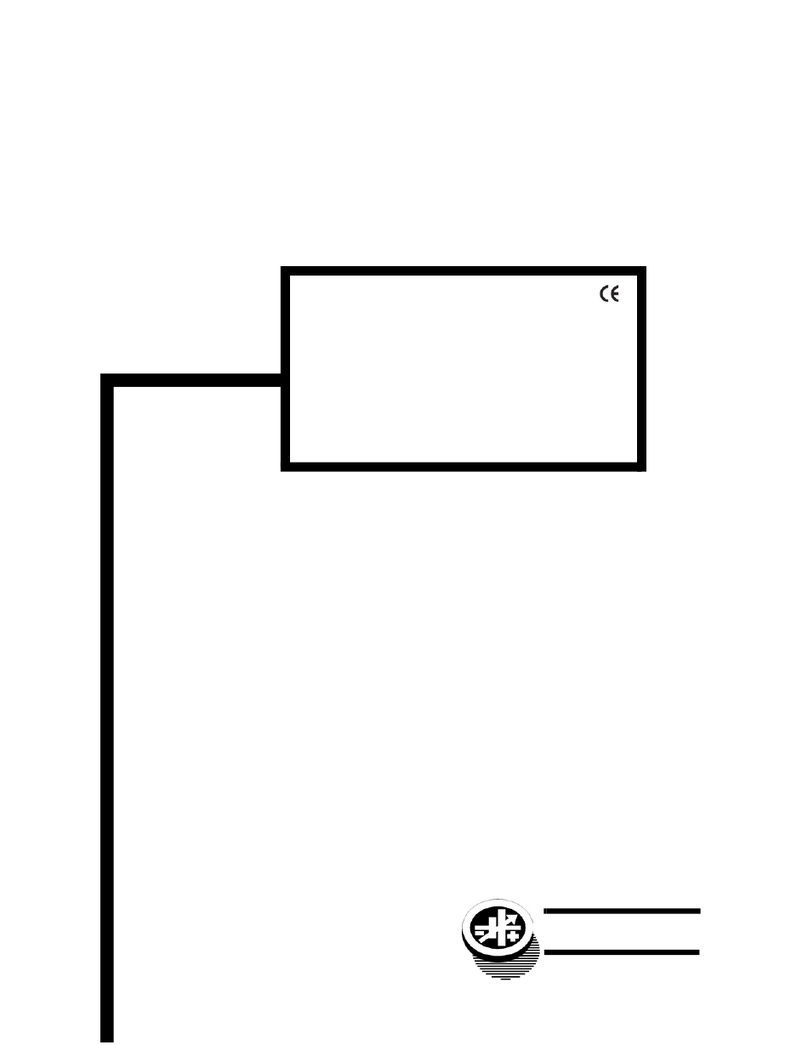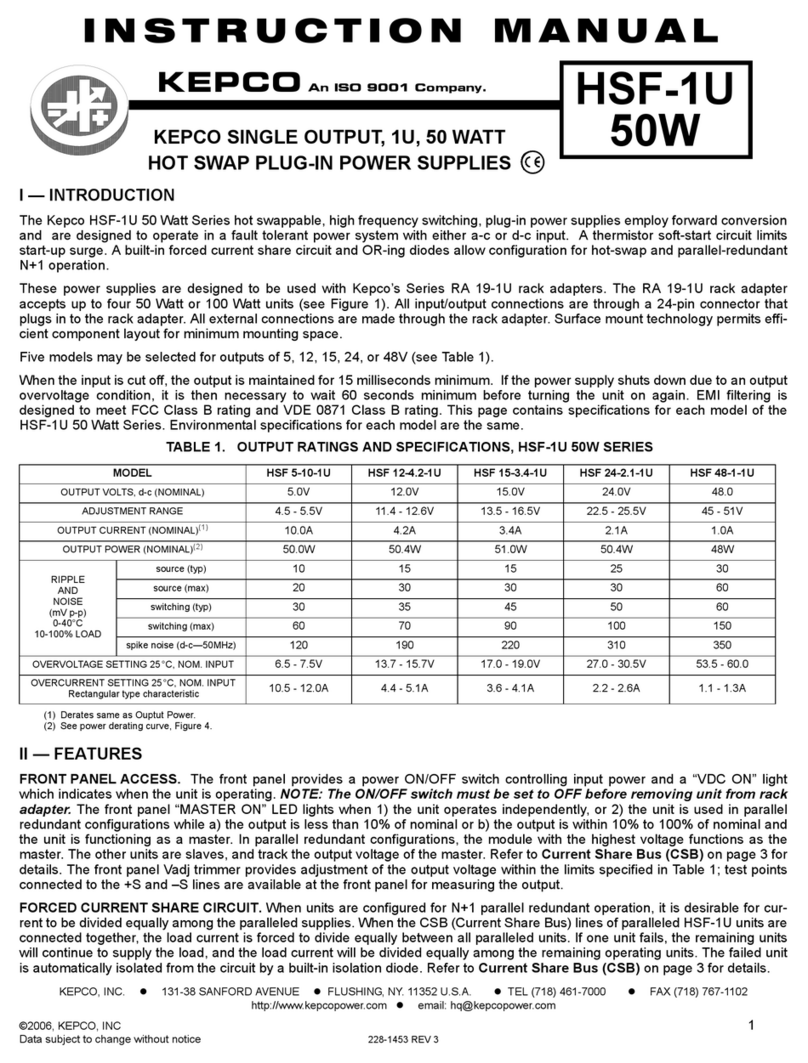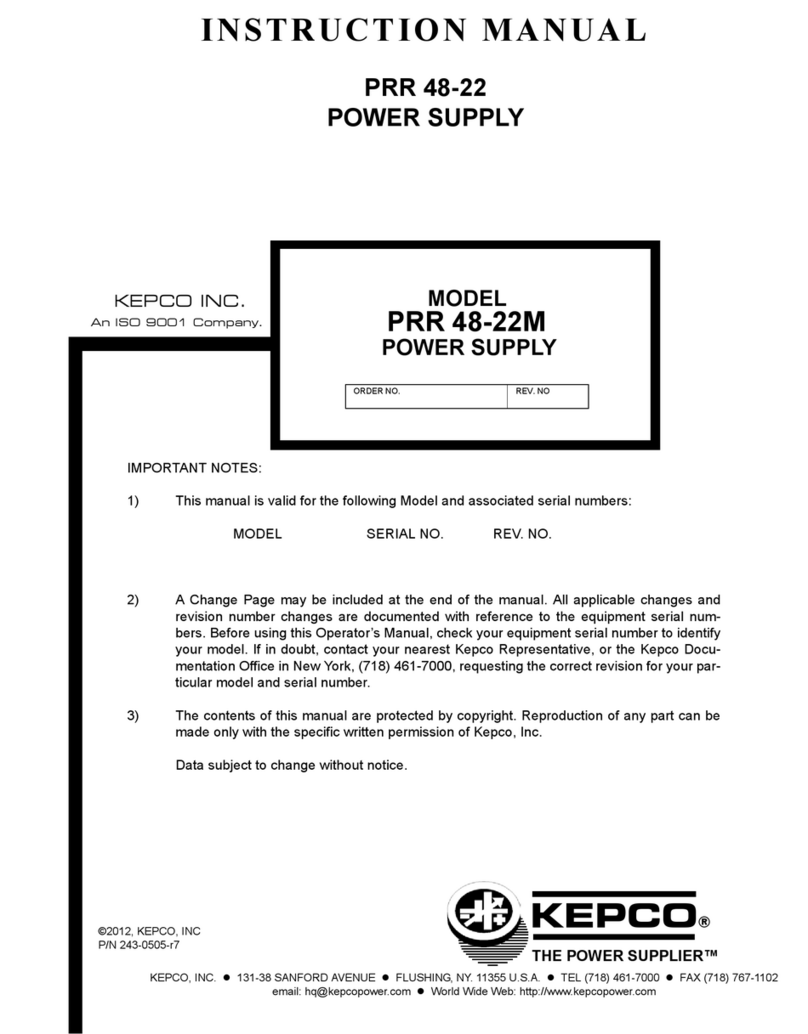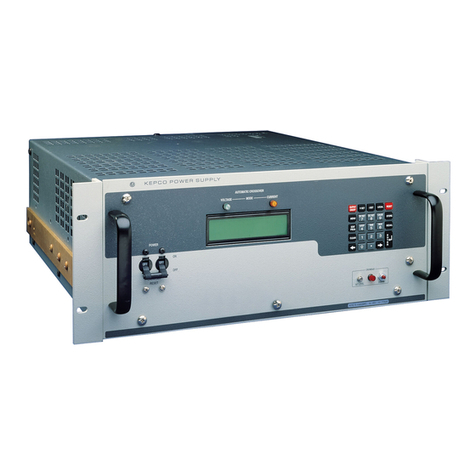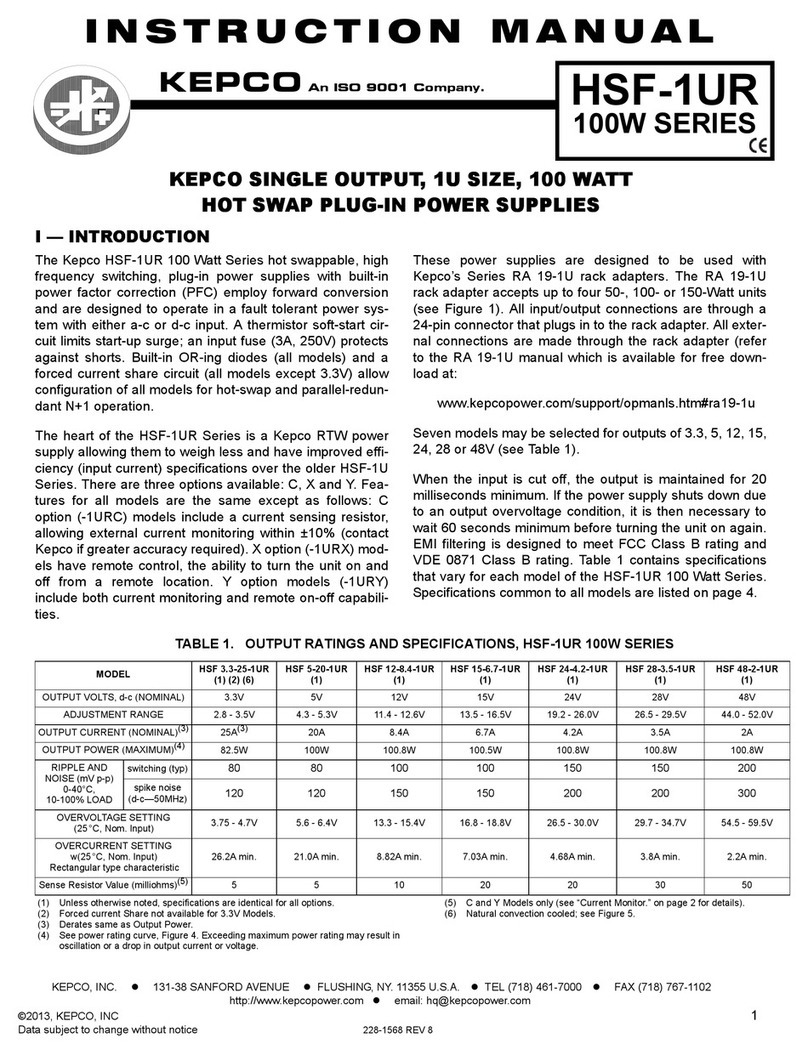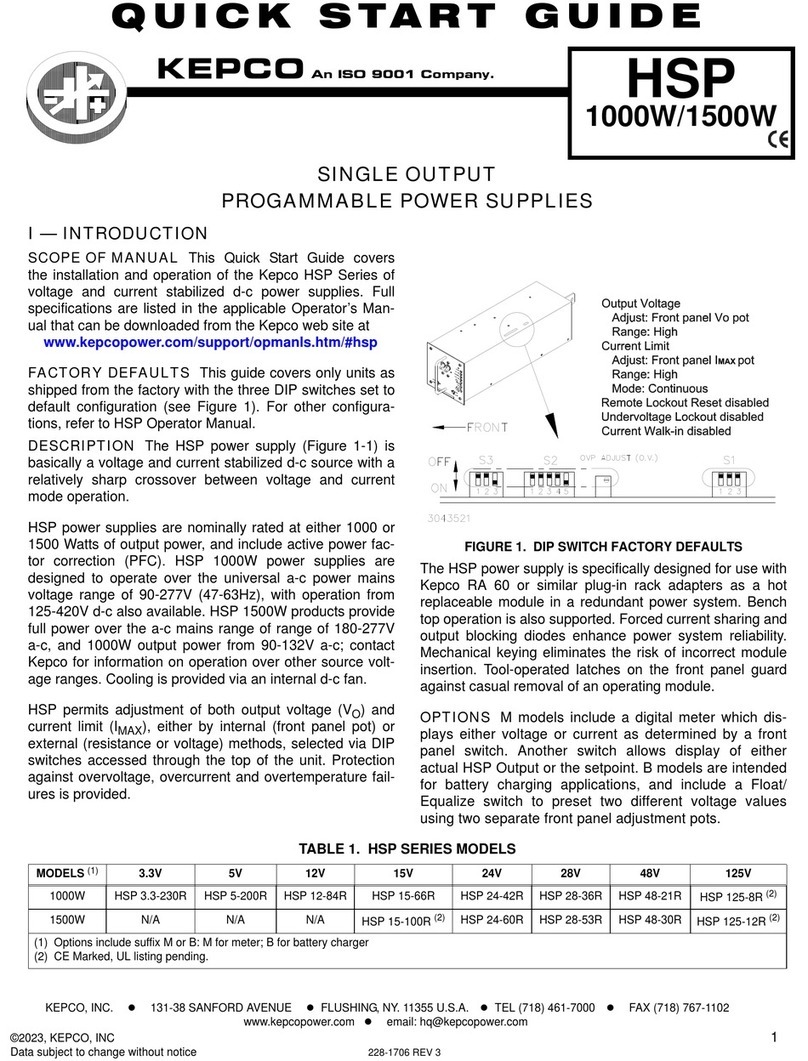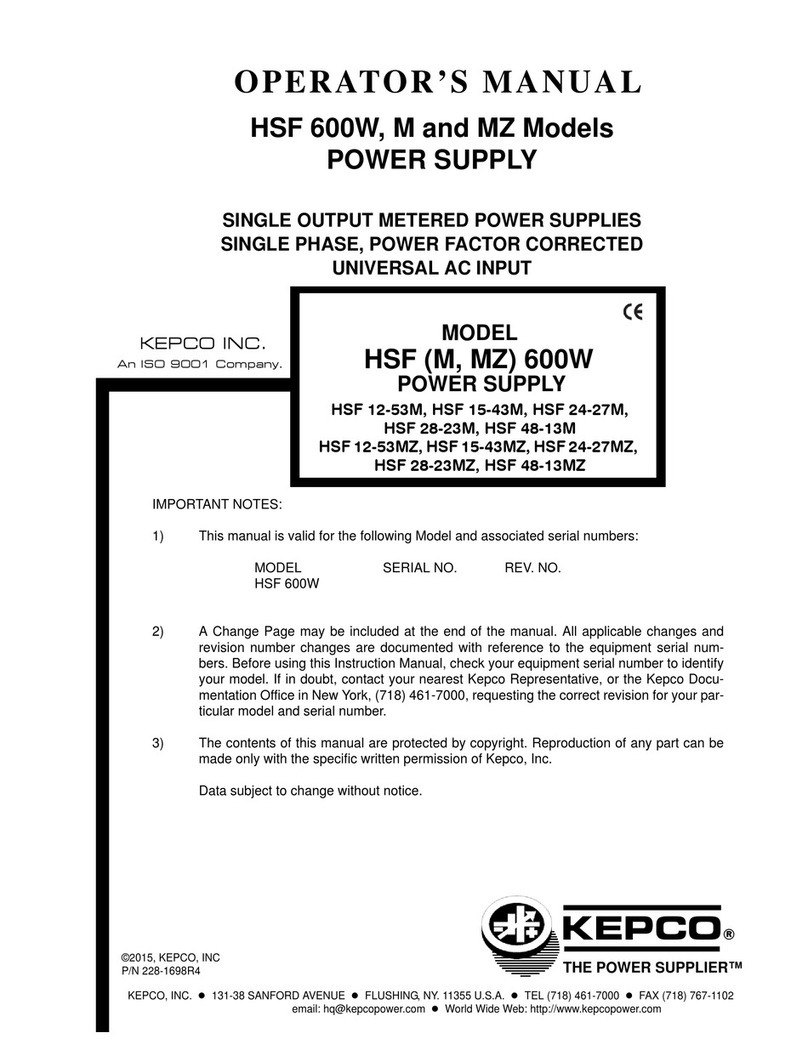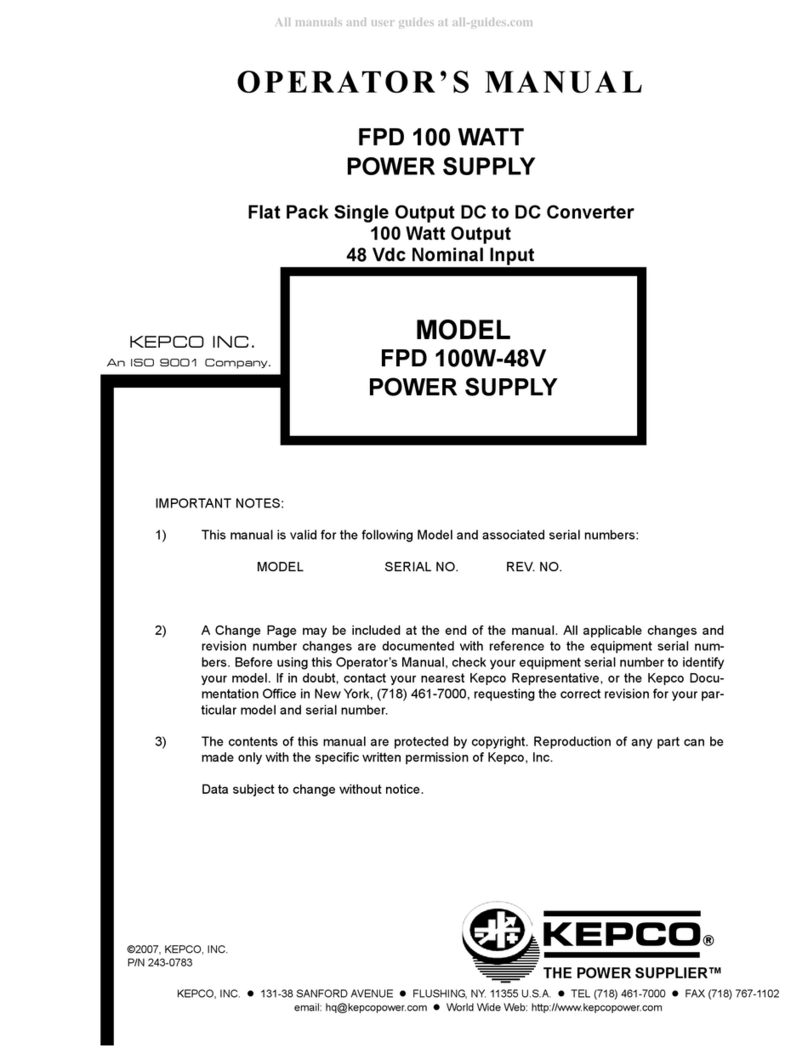
10 228-1699 REV 8 110918
KEPCO, INC. 131-38 SANFORD AVENUE FLUSHING, NY. 11355 U.S.A. TEL (718) 461-7000FAX (718) 767-1102
http://www.kepcopower.com email: hq@kepcopower.com
FAULT/LIMIT light turns green and the unit is
ready for operation; if it fails, the light turns red.
POWER SUPPLY BASICS. When in Voltage
mode, the power supply will (within the configured
and rated limits) provide the programmed output
voltage. Current is determined by the load, and can-
not exceed the Current Protect limits. If the protect
limit is reached, the POWER/FAULT/LIMIT LED light
changes from green (power OK) to orange.
When in Current mode, the power supply will (within
the configured and rated limits) provide the pro-
grammed output current. Voltage is determined by
the load, and cannot exceed the Voltage Protect lim-
its. If the protect limit is reached, the POWER/
FAULT/LIMIT LED light changes from green (power
OK) to orange.
VOLTAGE AND CURRENT PARAMETERS.
Table 5 defines the voltage and current parameters
used in this manual and provides references to the
SCPI commands and queries associated with the
parameter.
SETTING VOLTAGE OR CURRENT MODE.
The BOP-EL/GL uses two separate channels, one to
set output voltage or current and one to set the cor-
responding protection limit. The main channel is
determined by the power-up switches during normal
power-up:
Voltage Mode: S3-5 = 1, S3-1 = 1
Current Mode: S3-5 = 1, S3-1 = 0
The protection channel is determined automatically
by the main channel selected. When Voltage mode
is selected, the current protection channel is in use,
and when Current mode is selected, the Voltage pro-
tection channel is in use.
VOLTAGE/CURRENT PROTECT LIMITS
(LIMIT CHANNEL SOFTWARE LIMITS).
These values are the references for the complemen-
tary channels: voltage in current mode and current in
voltage mode. The range for these values is
between a minimum (box) value (see Figure 1) and
1% above the rated nominal value. If the unit is in
voltage mode, it will enter current protect mode
when the load demands more current and energy
than permitted by the ±current protect settings. Simi-
larly, if the unit is in current mode, it will enter voltage
protect mode if the load demands more voltage and
energy than permitted by the ±voltage protect set-
tings. When the protect settings are exceeded, the
protection channel limits the output current or volt-
age, the POWER/FAULT/LIMIT LED lights orange
(LIMIT), and the power supply continues operation
in the complementary mode of operation.
The BOP can be configured to program the protec-
tion limits as a single value that applies to both pro-
tection channels (using CURR:PROT:LIM or
VOLT:PROT:LIM) or by individual commands:
(CURR:PROT:LIM:POS, CURR:PROT:LIM:NEG,
VOLT:PROT:LIM:POS, VOLT:PROT:LIM:NEG) to
program individual settings for positive and negative
protection limits.
SOFTWARE LIMITS. The software limits for the
main channels (+Voltage Max, –Voltage Min, +Cur-
rent Max and –Current Min) are the maximum (posi-
tive) and minimum (Maximum negative) values
allowable for voltage and current. The default soft-
ware limits are determined by the model: the nomi-
nal (rated) values for voltage and current (e.g., 36V
and 28A for the BOP 36-28GL). These four values
can be adjusted independently. For example, a BOP
36-28GL, capable of delivering ±36V in voltage
mode can be configured to allow voltage to be
adjusted only from –1V to +15V by setting –Voltage
Min to –1 and +Voltage Max to +15. This can be
done by sending VOLT:LIM:POS 15 and
VOLT:LIM:NEG 1 commands via either GPIB or RS
232 ports.
NOTE: If main channel software limits are changed
from the default, the corresponding protection limits
are automatically set to 1% above the new maxi-
mum value. The complementary software limits are
unchanged - they must be changed manually if
needed.
MAXIMUM/MINIMUM PROTECTION LIM-
ITS (SOFTWARE-CONTROLLED). The ± pro-
tection limits are software limits that establish the maxi-
mum and minimum (maximum negative) allowable
levels of output voltage in current mode and current in
voltage mode. The default protection limits are 1%
above EOmax or 1% above IOmax.
CAUTION:
When working with active loads,
always adjust the BOP protection
limits to be above the maximum
values of voltage or current
expected from the load. For exam-
ple, when the BOP is operating in
voltage mode sinking energy from
a constant current type load, set
the current protection limits of the
BOP above the maximum current
expected from the load.
